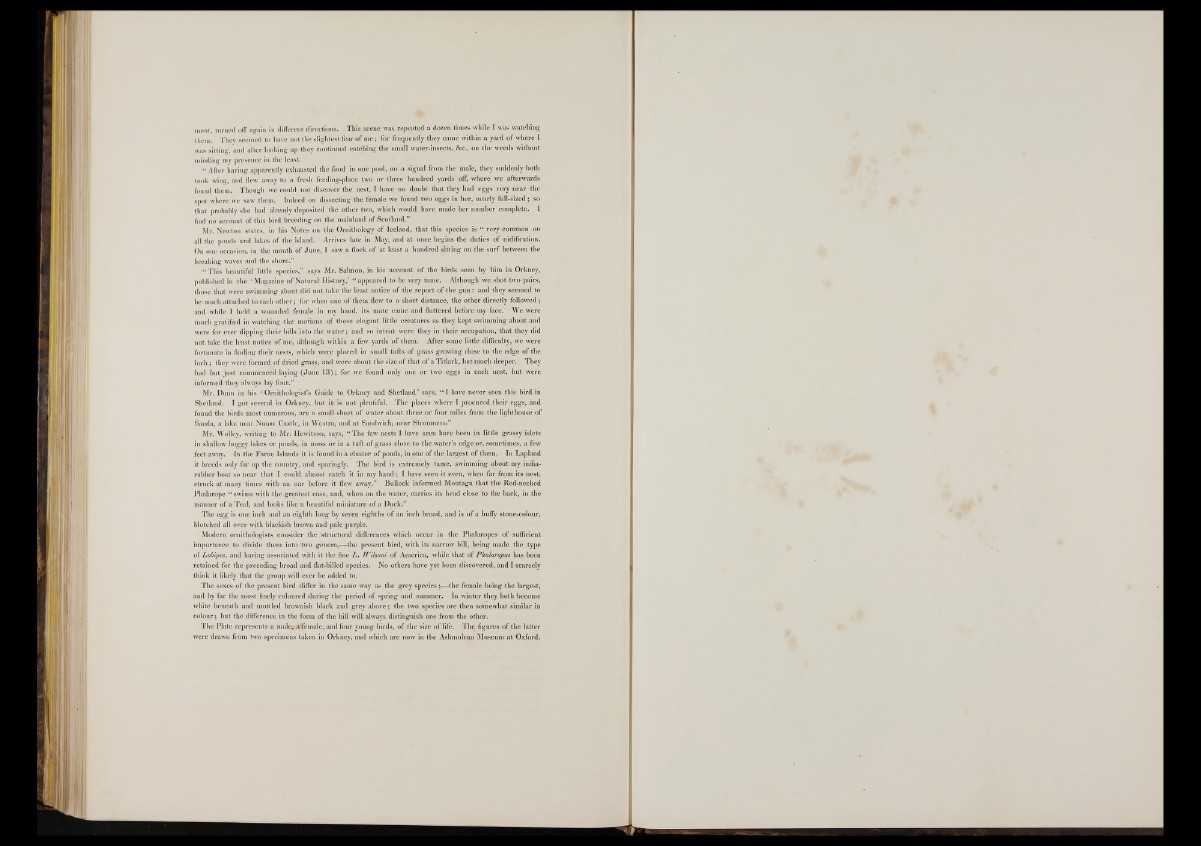
ment, turned off again in different directions. This scene was repeated a dozen times while I was watching
them. They seemed to have not the slightest fear o f me ; for frequently they came within a yard of where I
was sitting, and after looking up they continued catching the small water-insects, &c., on the weeds without
minding my presence in the least.
“ After having apparently exhausted the food in one pool, on a signal from the male, they suddenly both
took wing, and flew away to a fresh feeding-place two or three hundred yards off, where we afterwards
found them. Though we could not discover the nest, I have no doubt that they had eggs very near the
spot where we saw them. Indeed on dissecting the female we found two eggs in her, nearly full-sized ; so
that probably she had already deposited the other two, which would have made her number complete. I
find no account of this bird breeding on the mainland of Scotland.”
Mr. Newton states, in his Notes on the Ornithology o f Iceland, that this species is “ very common on
all the ponds and lakes of the island. Arrives late in May, and a t once begins the duties of nidification.
On one occasion, in the month of June, I saw a flock of at least a hundred sitting on the surf between the
breaking waves and the shore.”
“ This beautiful little species,” Says Mr. Salmon, in his account o f the birds seen by him in Orkney,
published in thè ‘ Magazine of Natural History,’ “ appeared to be very tame. Although we shot two pairs,
those that were swimming about did not take the least notice o f the report of the gun : and they seemed to
be much attached to each other ; for when one of them flew to a short distance, the other directly followed ;
and while I held a wounded female in my hand, its mate came and fluttered before my face. We were
much gratified in watching the motions of these elegant little creatures as they kept swimming about and
were for ever dipping their bills into the water ; and so intent were they in their occupation, that they did
not take the least notice of me, although within a few yards of them. After some little difficulty, we were
fortunate in finding their nests, which were placed in small tufts o f grass growing close to the edge o f the
loch ; they were formed of dried grass, and were about the size o f that o f a Titlark, but much deeper; They
had but just commenced laying (Ju n e 1 3 ); for we found only one or two eggs in each nest, but were
informed they always lay four:”
Mr. Dunn in his ‘ Ornithologist’s Guide to Orkney and Shetland ’ says, “ I have never seen this bird in
Shetland. I got several in Orkney, but it is not plentiful. The places where I procured their eggs, and
found the birds most numerous, are a small sheet of water about three or four miles from the lighthouse of
Sanda, a lake near Nunse Castle, in Westra, and a t Sandwich, near Stx’omness.”
Mr. Wolley, writing, to Mr. Hewitson, says, “ The few nests I have seen have been in little grassy islets
in shallow boggy lakes or ponds, in moss or in a tuft o f grass close to the water’s edge or, sometimes, a few
feet away. In the Faroe Islands it is found in a cluster o f ponds, in one of the largest o f them. In Lapland
it breeds only far up the country, and sparingly. The bird is extremely tame, swimming about my india-
rubber boat so near th at I could almost catch it in my hand ; I have seen it even, when far from its nest;
struck at many times with an oar before it flew away.” Bullock informed Montagu that the Red-necked
Phalarope “ swims with the greatest ease, and, when on the water, carries its head close to the back, in thé
manner of a Teal, and looks like a beautiful miniature of a Duck.”
The egg is one inch and an eighth long by seven eighths of an inch broad, and is of a buffy stone-colour;
blotched all over with blackish brown and pale purple.
Modern ornithologists consider the structural differences which occur in the Phalaropes o f sufficient
importance to divide them into two genera,—the present bird, with its narrow bill, being made the type
of Lobipes, and having associated with it the fine L . Wilsoni of America, while that of Phalaropus has been
retained for the preceding broad and flat-billed species. No others have yet been discovered, and I scarcely
think it likely that the group will ever be added to.
The sexes o f the present bird differ in the same way as the grey species ;— the female being the largest,
and by far the most finely coloured during the period o f spring and summer. In winter they both become
white beneath and mottled brownish black and grey above ; the two species are then somewhat similar in
colour ; but the difference in the form of the bill will always distinguish one from the other.
The Plate represents a male,, affemale, and four young birds, of the size o f life; The figures o f the latter
were drawn from two specimens taken in Orkney, and which are now in the Ashmolean Museum a t Oxford.